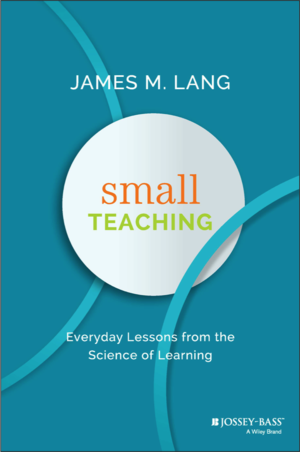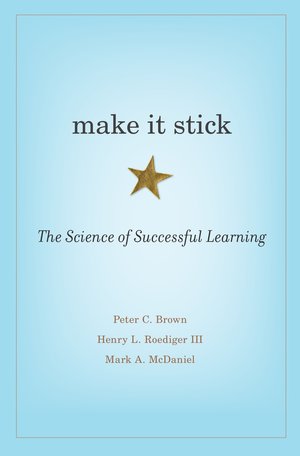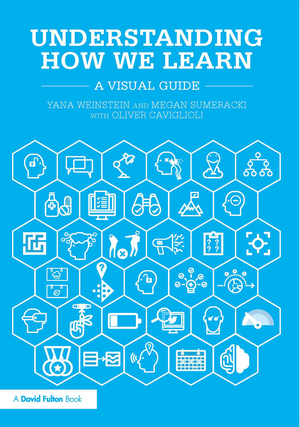Recommended books from RetrievalPractice.org
Check out our recommended books and reports that describe research on the science of learning and provide practical tips for classroom teaching.




…plus several others




Recommended books from RetrievalPractice.org
Check out our recommended books and reports that describe research on the science of learning and provide practical tips for classroom teaching.




…plus several others
5 Research-Backed Studying Techniques — from edutopia.org by Edward Kang
Teachers can guide students to avoid ineffective studying habits in favor of ones that will increase their learning outcomes.
Excerpts:
Ineffective techniques include:
The book Make It Stick identifies several research-proven studying techniques.
Artsonia recognizes 15 teachers around the nation with 2019 Art Education Leadership Award — from prnewswire.com with thanks to Bob Spoerl for these resources
Student art platform Artsonia recognizes art educators who are pioneers in their community
Also see this page on Artsonia with more details about each recognized teacher:
The Common Sense Census: Inside the 21st-Century Classroom
Excerpt:
Technology has become an integral part of classroom learning, and students of all ages have access to digital media and devices at school. The Common Sense Census: Inside the 21st-Century Classroom explores how K–12 educators have adapted to these critical shifts in schools and society. From the benefits of teaching lifelong digital citizenship skills to the challenges of preparing students to critically evaluate online information, educators across the country share their perspectives on what it’s like to teach in today’s fast-changing digital world.
Microsoft debuts Ideas in Word, a grammar and style suggestions tool powered by AI — from venturebeat.com by Kyle Wiggers; with thanks to Mr. Jack Du Mez for his posting on this over on LinkedIn
Excerpt:
The first day of Microsoft’s Build developer conference is typically chock-full of news, and this year was no exception. During a keynote headlined by CEO Satya Nadella, the Seattle company took the wraps off a slew of updates to Microsoft 365, its lineup of productivity-focused, cloud-hosted software and subscription services. Among the highlights were a new AI-powered grammar and style checker in Word Online, dubbed Ideas in Word, and dynamic email messages in Outlook Mobile.
Ideas in Word builds on Editor, an AI-powered proofreader for Office 365 that was announced in July 2016 and replaced the Spelling & Grammar pane in Office 2016 later that year. Ideas in Words similarly taps natural language processing and machine learning to deliver intelligent, contextually aware suggestions that could improve a document’s readability. For instance, it’ll recommend ways to make phrases more concise, clear, and inclusive, and when it comes across a particularly tricky snippet, it’ll put forward synonyms and alternative phrasings.
Also see:
Three ways to use video feedback to enhance student engagement — from scholarlyteacher.com by Christopher Penna
Excerpt:
An innovative approach for providing feedback on student work in a variety of disciplines is the use of screen capture videos (Mathisen). These videos allow for the recording of what is on the instructor’s screen (for example, a student paper) accompanied by audio narration describing strengths and weaknesses of the work being discussed as well as any edits that the instructor is making on the page. Once created, the video is available to the student for repeated viewing. Research indicates these videos provide more concrete and effective guidance for students and a higher level of student engagement than traditional written comments and rubrics (Jones, Georghiades, & Gunson, 2012; Thompson & Lee, 2012).
A growing repository of useful design tools, from accessibility and AR to wireframing and 3D modeling software.
? Awesome Design Toolshttps://t.co/qo5wAU9D4d pic.twitter.com/THIYPLmH0c
— Smashing Magazine (@smashingmag) April 10, 2019
An excerpt from a recent e-newsletter from Pooja K. Agarwal, Ph.D. from RetrievalPractice.org
Want more tips for building rapport with students? We highly recommend Professor James Lang’s series in the Chronicle of Higher Education on how to make the most of:
We love his book, Small Teaching. It’s full of practical teaching strategies and the science behind them. For example, combine retrieval, spacing, feedback, and more with quick and easy Connection Notebooks!
Excerpt from the last 5 minutes of class (emphasis DSC):
Don’t waste them trying to cram in eight more points or call out as many reminders as possible
The minute paper. You can’t wade very far into the literature of teaching and learning in higher education without encountering some version of the Minute Paper, a technique made justly famous by Thomas A. Angelo and K. Patricia Cross in their book Classroom Assessment Techniques: A Handbook for College Teachers. The Minute Paper comes in many variations, but the simplest one involves wrapping up the formal class period a few minutes early and posing two questions to your students:
Taken together, those two questions accomplish multiple objectives. The first one not only requires students to remember something from class and articulate it in their own words (more about that in a moment), but it also requires them to do some quick thinking. They have to reflect on the material and make a judgment about the main point of that day’s class.
For those of you students majoring Education, check this Tweet out and the responses he received!!! See what I mean!!!!
Friends, I am teaching a University course filled with "new to twitter" teachers.
Can you recmonned three great accounts ALL teachers should follow?
Thanks! #CodeBreaker #BlockBreaker
— Brian Aspinall (@mraspinall) March 25, 2019
In the last 10 years, I have written over 2000 provincial certification exam questions and reviewed more than 10000 questions written by tech writers. This resource is the best I have seen and I endorse every tip. What an excellent job by @caranorth11 and @mshEducation https://t.co/1nTpOaU6xt
— Taruna Goel (@write2tg) April 2, 2019
If you missed our presentation (@mshEducation) at #LSCon about writing better multiple-choice test items, you can get the resources here: https://t.co/I4k6Vxa0Rk
We've also been asked to do an encore via webinar to dive into this again. Once we have it finalized, we will share. pic.twitter.com/WlkGU9Pjlr— Cara North #ATD2019 (@caranorth11) April 1, 2019
Educational Web Tools to Empower Students Voice in Class — from educatorstechnology.com
Excerpt:
At the core of progressive pedagogy is the empowerment of students by giving them a voice in class and making them part of the decision making. Unlike traditional instruction where students are viewed as passive receivers of pre-designed knowledge, a progressive instruction is primarily student-centered and dialogic in nature. It views students as subjects with a sense of agency capable of co-constructing their own knowledge. This pedagogical stance is especially popularized by educationists such as John Dewy, Paulo Freire, Maxine Greene, and Vygotsky. For these theorists, learning is driven by curiosity, inquiry and self-discovery, processes which involve students in their own learning and makes their learning meaningful.
With the help of web technologies, you can use a wide variety of web tools with students to provide them with an outlet through which they can express their voices. Here are some examples to try …
From DSC:
I ran into the posting below on my Twitter feed. I especially want to share it with all of those students out there who are majoring in Education. You will find excellent opportunities to build your Personal Learning Network (PLN) on Twitter.
But this idea/concept/opportunity also applies to current teachers, professors, trainers, special educators, principals, superintendents, school board members, coaches, and many, many others.
You will not only learn a great deal by tapping into those streams of content, but you will be able to share your own expertise, insights, resources, reflections, etc. Don’t underestimate the networking and learning potential of Twitter. It’s one of the top learning tools in the world.
One last thought before you move onto the graphics below…K-12 educators are doing a super job of networking and sharing resources with each other. I hope that more faculty members who are working within higher education can learn from the examples being set forth by K-12 educators.
Also see:
Also see:
From DSC:
First of all, an article:
The four definitive use cases for AR and VR in retail — from forbes.com by Nikki Baird
Excerpt (emphasis DSC):
AR is the go-to engagement method of choice when it comes to product and category exploration. A label on a product on a shelf can only do so much to convey product and brand information, vs. AR, which can easily tap into a wealth of digital information online and bring it to life as an overlay on a product or on the label itself.
From DSC:
Applying this concept to the academic world…what might this mean for a student in a chemistry class who has a mobile device and/or a pair of smart goggles on and is working with an Erlenmeyer flask? A burette? A Bunsen burner?
Along these lines...what if all of those confused students — like *I* was struggling through chem lab — could see how an experiment was *supposed to be done!?*
That is, if there’s only 30 minutes of lab time left, the professor or TA could “flip a switch” to turn on the AR cloud within the laboratory space to allow those struggling students to see how to do their experiment.
I can’t tell you how many times I was just trying to get through the lab — not knowing what I was doing, and getting zero help from any professor or TA. I hardly learned a thing that stuck with me…except the names of a few devices and the abbreviations of a few chemicals. For the most part, it was a waste of money. How many students experience this as well and feel like I did?
Will the terms “blended learning” and/or “hybrid learning” take on whole new dimensions with the onset of AR, MR, and VR-related learning experiences?
#IntelligentTutoring #IntelligentSystems #LearningExperiences
#AR #VR #MR #XR #ARCloud #AssistiveTechnologies
#Chemistry #BlendedLearning #HybridLearning #DigitalLearning
Also see:
“It is conceivable that we’re going to be moving into a world without screens, a world where [glasses are] your screen. You don’t need any more form factor than [that].”
(AT&T CEO)
To Differentiate: Lower Floors and Raise Ceilings — from byrdseed.com by Ian Bryd
When you’re planning a task for a wide range of students, the terms “floor” and “ceiling” are easy mental shortcuts to increase the range of success for all kids.
Excerpt:
It should be our goal to develop tasks that all students can get started with, but that also scale up for students who are ready for more. This is the easiest way to create a task that can work for everyone.
My friend Lisa has a fantastic piece of differentiation advice:
Plan for your highest-ability students first, then figure out how to onboard your other learners.
Why? Because it’s really hard to increase the ceiling on a worksheet. It’s much easier to lower the floor on, say, a research project. You can always scaffold down – but you can’t always raise the ceiling.
Aiming for a low floor and high ceiling supports all students. Plus, it gives even low-performing kids a chance to go somewhere interesting. You’ll never know who will take advantage of that high ceiling.